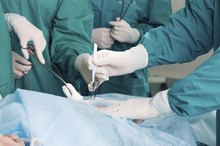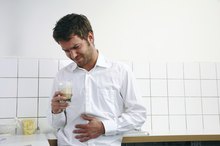What does fact checked mean?
At Healthfully, we strive to deliver objective content that is accurate and up-to-date. Our team periodically reviews articles in order to ensure content quality. The sources cited below consist of evidence from peer-reviewed journals, prominent medical organizations, academic associations, and government data.
The information contained on this site is for informational purposes only, and should not be used as a substitute for the advice of a professional health care provider. Please check with the appropriate physician regarding health questions and concerns. Although we strive to deliver accurate and up-to-date information, no guarantee to that effect is made.
Hernias are defined as “protrusions of an organ or tissue through an opening in its surrounding walls, especially in the abdominal region." They are relatively common and easily treatable. However, complications can occur in rare cases, making hernias dangerous and life threatening. Perhaps the worst of these is the burst hernia. In reading about hernias, you will generally find “burst” used in two ways. The first is not so serious, the second is life threatening.
If you are experiencing serious medical symptoms, seek emergency treatment immediately.
Burst Hernia Repairs
Many times, hernias are caused because there is a hole in the abdominal wall. If this is the case, surgery to close the hole may be recommended. This is not a surefire cure, though. In some case, the repairs may burst open 1. This means the repair did not hold.
- Many times, hernias are caused because there is a hole in the abdominal wall.
- In some case, the repairs may burst open 1.
Signs Hernia Repairs Burst
Hernia Symptoms for Women
Learn More
If you have had hernia repair, you will know it has burst if your hernia returns. You will see the return of the bulge caused by the hernia, along with the same types of pain you felt originally. The hernia needs to be repaired once again to keep from getting sepsis.
Signs of Serious Hernia Problems
One sign of a hernia is that it can generally be pushed back inside the abdominal wall or reduced. Because of entanglements with other organs and tissue, some hernias can’t be reduced. These hernias are more painful and can cause bowel obstruction, nausea and vomiting. The danger with these hernias is that the blood supply can be cut off. This is called strangulation. Once the blood supply is cut off, the tissue can die in as few as six hours. The hernia will be painful and tender if this is the case. The person with the hernia may even look and feel ill, but won’t have a fever. At this point, the hernia has become a medical emergency that requires surgery.
- One sign of a hernia is that it can generally be pushed back inside the abdominal wall or reduced.
- The danger with these hernias is that the blood supply can be cut off.
Burst Hernia
Symptoms of Inguinal Hernia Pain From a Bicycle
Learn More
If the strangulation is severe enough, the portion of intestine being strangled may burst open, causing intense pain. You would then become septic and have a high fever. At this point, surgical repair becomes a medical emergency.
Seek Medical Care
If you find any hernias or believe you have symptoms that could indicate a hernia, visit your doctor. While you might not feel discomfort at first, burst hernias are serious. Both types of burst hernias can cause sepsis, which is a poisoning of the blood from the introduction of putrefied material.
Related Articles
References
- A Paper on Burst Abdomens
- Fitzgibbons RJ, Forse RA. Groin hernias in adults. N Engl J Med. 2015;372(8):756-763. doi:10.1056/NEJMcp1404068
- Merriam-Webster Dictionary. Definition of HARUSPEX. Updated 2020.
- Mahadevan V. Essential Anatomy of the Abdominal Wall. In: Kingsnorth A, LeBlanc K, eds. Management of Abdominal Hernias. Fourth. London: Springer Science & Business Media; 2013:25-55.
- M BS. SRB’s Manual of Surgery. Sixth. London: Jaypee Brothers, Medical Publishers Pvt. Limited; 2019:739-776.
- Wang H, Naghavi M, Allen C, Barber R, Bhutta ZA, Carter A. Global, regional, and national life expectancy, all-cause mortality, and cause-specific mortality for 249 causes of death, 1980–2015: a systematic analysis for the Global Burden of Disease Study 2015. The Lancet. 2016;388(10053):1459-1544. doi:10.1016/S0140-6736(16)31012-1
- Hoffmann H, Walther D, Bittner R, Köckerling F, Adolf D, Kirchhoff P. Smaller inguinal hernias are independent risk factors for developing chronic postoperative inguinal pain (CPIP). Annals of Surgery. 2020;271(4):756-764. doi:10.1097/SLA.0000000000003065
- Dhua AK, Aggarwal SK, Mathur N, Sethi G. Bilateral congenital diaphragmatic hernia. APSP J Case Rep. 2012;3(3):20. PMID: 23061036
Writer Bio
James Rada, Jr. was a newspaper reporter for eight years and earned 23 awards from the Maryland Delaware D.C. Press Association, Associated Press, Society of Professional Journalists, Maryland State Teachers’ Association and CNHI. He also worked for 12 years as a marketing communications writer, earning a Print Copywriter of the Year Award from the Utah Ad Federation. He holds a Bachelor of Arts in communications.








